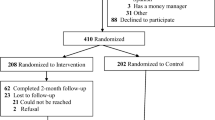Abstract
Smoking is associated with a number of chronic health conditions, including cardiovascular disease and various types of cancer. The decision to smoke can be conceptualized as preference for small, immediate rewards (e.g., relief from withdrawal) over larger, delayed rewards (e.g., good health). Contingency management (CM) takes advantage of this preference for immediate outcomes by delivering incentives, usually financial, for making the healthier choice to abstain from smoking. The current study tested the feasibility of harnessing naturally occurring social contingencies associated with smoking cessation to increase the promise of CM in initiating and sustaining long-term abstinence. Pairs of smokers with an existing relationship (i.e., friends, roommates, family, significant others) were recruited to quit together in the context of a smartphone-delivered, group CM intervention. Approximately 50% of interested participants identified a partner who also met criteria to participate, and five pairs (N = 10) completed the study. Using a within-subject design, participants could earn individual financial incentives for submitting breath carbon monoxide (CO) samples twice daily that met targeted goals for abstinence, and they could earn bonus incentives when both members of the pair met their targets together. Nine participants (90%) successfully reduced their mean breath CO during the intervention relative to baseline conditions. Individuals within a pair performed similarly to one another, for better or worse (i.e., both participants abstained, smoked, or missed samples at the same time). The social contingencies of quitting with someone with whom the smoker has an existing relationship may be helpful, but may also introduce unique challenges, particularly with regard to recruitment and treatment retention.


Similar content being viewed by others
References
Ahmed, J., King, B. A., Neff, L. J., Whitmill, J., Babb, S. D., & Graffunder, C. M. (2016). Current cigarette smoking among adults — United States, 2005–2015. Morbidity and Mortaility Weekly Report (MMWR), 65(44), 1205-1211.
Baer, D. M., & Wolf, M. M. (1967). The entry into natural communities of reinforcement. Washington, DC: Office of Education, U.S. Department of Health, Education, & Welfare.
Bickel, W. K., & Marsch, L. A. (2001). Toward a behavioral economic understanding of drug dependence: Delay discounting processes. Addiction, 96(1), 73–86.
Borrero, J. C., Crsolo, S. S., Tu, Q., Rieland, W. A., Ross, N. A., Francisco, M. T., & Yamamato, K. Y. (2007). An application of the matching law to social dynamics. Journal of Applied Behavior Analysis, 40, 589–601.
CDC. (2016a). Fact sheet: Health effects of cigarette smoking—Smoking & tobacco use. Retrieved from http://www.cdc.gov/tobacco/data_statistics/fact_sheets/health_effects/effects_cig_smoking/index.htm
CDC. (2016b) Fact sheet: Tobacco-related Mortaility—Smoking and tobacco use. Retrieved from https://www.cdc.gov/tobacco/data_statistics/fact_sheets/health_effects/tobacco_related_mortality/index.htm
CDC. (2017). Fact sheet: Quitting smoking—smoking & tobacco use. Retrieved from http://www.cdc.gov/tobacco/data_statistics/fact_sheets/cessation/quitting/
Christakis, N. A., & Fowler, J. H. (2008). The collective dynamics of smoking in a large social network. New England Journal of Medicine, 358(21), 2249–2258. doi:10.1056/NEJMsa0706154.
Clinical Practice Guideline Treating Tobacco Use and Dependence 2008 Update Panel, Liaisons, and Staff. (2008). A clinical practice guideline for treating tobacco use and dependence: 2008 update. A U.S. public health service report. American Journal of Preventive Medicine, 35(2), 158–176. doi:10.1016/j.amepre.2008.04.009.
Dallery, J., Glenn, I. M., & Raiff, B. R. (2007). An internet-based abstinence reinforcement treatment for cigarette smoking. Drug and Alcohol Dependence, 86(2/3), 230–238. doi:10.1016/j.drugalcdep.2006.06.013.
Dallery, J., Meredith, S., Jarvis, B., & Nuzzo, P. A. (2015). Internet-based group contingency management to promote smoking abstinence. Experimental and Clinical Psychopharmacology, 23(3), 176–183. doi:10.1037/pha0000013.
Dallery, J., Raiff, B. R., & Grabinski, M. J. (2013). Internet-based contingency management to promote smoking cessation: A randomized controlled study. Journal of Applied Behavior Analysis, 46(4), 750–764. doi:10.1002/jaba.89.
Dallery, J., Raiff, B. R., Kim, S. J., Marsch, L. A., Stitzer, M., & Grabinski, M. J. (2016). Nationwide access to an Internet-based contingency management intervention to promote smoking cessation: A randomized controlled trial. Addiction. doi:10.1111/add.13715.
Dan, M., Grabinski, M. J., & Raiff, B. R. (2016). Smartphone-based contingency management for smoking cessation with smokers diagnosed with attention-deficit/hyperactivity disorder. Translational Issues in Psychological Science, 2(2), 116–127. doi:10.1037/tps0000062.
Fiore, M. C., Bailey, W. C., Cohen, S. J., Dorfman, S. F., Goldstein, M. G., Gritz, E. R.,…Mecklenburg, R. E. (2000). Treating tobacco use and dependence: Clinical practice guideline. Rockville, MD: U.S. Department of Health and Human Services.
Heatherton, T. F., Kozlowski, L. T., Frecker, R. C., & Fagerstrom, K. O. (1991). The fagerström test for nicotine dependence: A revision of the fagerstrom tolerance questionnaire. Addiction, 86(9), 1119–1127.
Herrnstein, R. J. (1970). On the law of effect. Journal of the Experimental Analysis of Behavior, 13, 243–266. doi:10.1901/jeab.1970.13-243.
Hertzberg, J. S., Carpenter, V. L., Kirby, A. C., Calhoun, P. S., Moore, S. D., Dennis, M. F.,…Beckham, J. C. (2013). Mobile contingency management as an adjunctive smoking cessation treatment for smokers with posttraumatic stress disorder. Nicotine & Tobacco Research: Official Journal of the Society for Research on Nicotine and Tobacco, 15(11), 1934–1938. doi:10.1093/ntr/ntt060
Higgins, S. T., Silverman, K., & Heil, S. H. (Eds.). (2007). Contingency management in substance abuse treatment. New York, NY: Guilford Press.
Kirby, K. C., Kerwin, M. E., Carpenedo, C. M., Rosenwasser, B. J., Gardner, R. S., & Silverman, K. (2008). Interdependent group contingency management for cocaine-dependent methadone maintenance patients. Journal of Applied Behavior Analysis, 41(4), 579–595. doi:10.1901/jaba.2008.41-579.
Madden, G. J., & Bickel, W. K. (Eds.). (2010). Impulsivity: The behavioral and neurological science of discounting. Washington DC: American Psychological Association. doi:10.1037/12069-000
Meredith, S. E., & Dallery, J. (2013). Investigating group contingencies to promote brief abstinence from cigarette smoking. Experimental and Clinical Psychopharmacology, 21(2), 144–154. doi:10.1037/a0031707.
Meredith, S. E., Grabinski, M. J., & Dallery, J. (2011). Internet-based group contingency management to promote abstinence from cigarette smoking: A feasibility study. Drug and Alcohol Dependence, 118(1), 23–30. doi:10.1016/j.drugalcdep.2011.02.012.
Mermelstein, R., Cohen, S., Lichtenstein, E., Baer, J. S., & Kamarck, T. (1986). Social support and smoking cessation and maintenance. Journal of Consulting and Clinical Psychology, 54(4), 447–453. doi:10.1037/0022-006X.54.4.447.
Murray, R. P., Johnston, J. J., Dolce, J. J., Lee, W. W., & O’Hara, P. (1995). Social support for smoking cessation and abstinence: The lung health study. Addictive Behaviors, 20(2), 159–170. doi:10.1016/S0306-4603(99)80001-X.
Ortendahl, M., & Fries, J. F. (2002). Time-related issues with application to health gains and losses. Journal of Clinical Epidemiology, 55(9), 843–848. doi:10.1016/S0895-4356(02)00447-X.
Patten, C. A., Hughes, C. A., Lopez, K. N., Thomas, J. L., Brockman, T. A., Smith, C. M.,…Offord, K. P. (2012). Web-based intervention for adolescent nonsmokers to help parents stop smoking: A pilot feasibility study. Addictive Behaviors, 37(1), 85–91. doi:10.1016/j.addbeh.2011.09.003
Rash, C. J., Olmstead, T. A., & Petry, N. M. (2009). Income does not affect response to contingency management treatments among community substance abuse treatment-seekers. Drug and Alcohol Dependence, 104, 249–253.
Watson, P. J., & Workman, E. A. (1981). The non-concurrent multiple baseline across-individuals design: An extension of the traditional multiple baseline design. Journal of Behavior Therapy and Experimental Psychiatry, 12(3), 257–259. doi:10.1016/0005-7916(81)90055-0.
Acknowledgements
The authors would like to thank Moran Dan and Jaime Pierce for their help with recruiting participants, and Jesse Dallery for his help reviewing an earlier version of this manuscript. This research was supported with start-up funds at Rowan University awarded to the corresponding author.
Author information
Authors and Affiliations
Corresponding author
Ethics declarations
Disclosure of Potential Conflicts of Interest
On behalf of all authors, the corresponding author states that there is no conflict of interest.
Research Involving Human Participants
All procedures involving human subjects participation were approved by the Institutional Review Board at the corresponding author’s institution.
Informed Consent
All participants completed the informed consent process prior to completing research activities.
Rights and permissions
About this article
Cite this article
Raiff, B.R., Arena, A., Meredith, S.E. et al. Feasibility of a Mobile Group Financial-Incentives Intervention Among Pairs of Smokers With a Prior Social Relationship. Psychol Rec 67, 231–239 (2017). https://doi.org/10.1007/s40732-017-0238-z
Published:
Issue Date:
DOI: https://doi.org/10.1007/s40732-017-0238-z




